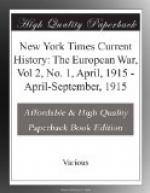I think the committee will be interested to know what the actual cost of the war will have been to this country as far as we can estimate on March 31, the close of the financial year. The war will then have lasted for 240 days and the votes of credit up to that time, assuming this vote is carried, will amount to L362,000,000. It may be said, speaking generally, that the average expenditure from votes of credit will have been, roughly, L1,500,000 per day throughout the time. That, of course, is the excess due to the war over the expenditure on a peace footing. That represents the immediate charge to the taxpayers of this country for this year. But, as the committee knows, a portion of the expenditure consists of advances for the purpose of assisting or securing the food supplies of this country and will be recoverable in whole, or to a very large extent, in the near future. A further portion represents advances to the dominions and to other States which will be ultimately repaid. If these items are excluded from the account the average expenditure per day of the war is slightly lower, but after making full allowance for all the items which are in the nature of recoverable loans, the daily expenditure does not work out at less than L1,200,000.
These figures are averages taken over the whole period from the outbreak of the war, but at the outbreak of the war, after the initial expenditure on mobilization had been incurred, the daily expenditure was considerably below the average, as many charges had not yet matured. The expenditure has risen steadily and is now well over the daily average that I have given. To that figure must be added, in order to give a complete account of the matter, something for war services other than naval or military. At the beginning of the year these charges are not likely to be very considerable, but it will probably be within the mark to say that from April I we shall be spending over L1,700,000 a day above the normal, in consequence of the war.
Perhaps now I may say something which is not strictly in order on this vote, but concerns the vote of credit for the ensuing year, which amounts, as appears on the paper, to L250,000,000. The committee will at once observe an obvious distinction between the votes of credit taken for the current financial year and that which we propose to take for the ensuing year. As I have already pointed out, at the outbreak of war the ordinary supply of the year had been granted




